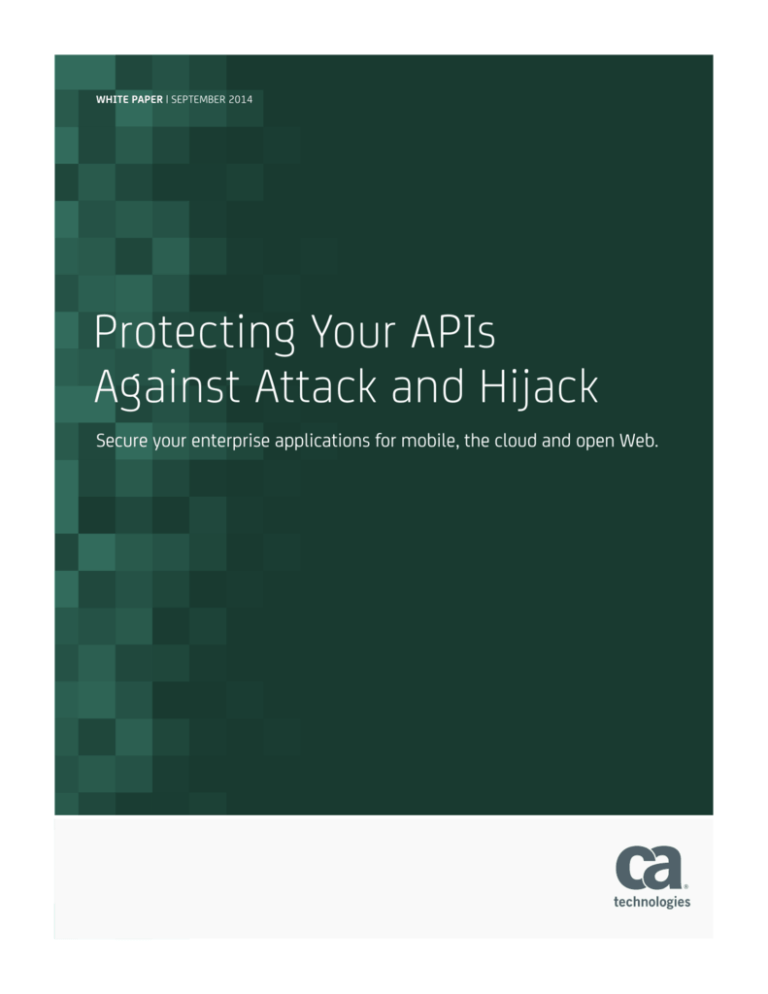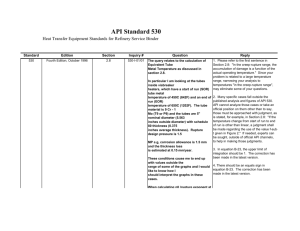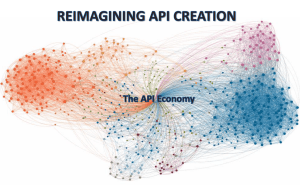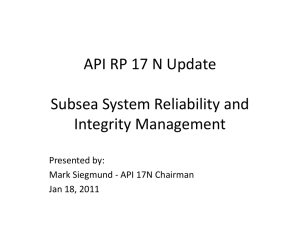
WHITE PAPER | SEPTEMBER 2014
Protecting Your APIs
Against Attack and Hijack
Secure your enterprise applications for mobile, the cloud and open Web.
2 | WHITE PAPER: PROTECTING YOUR APIS AGAINST ATTACK AND HIJACK
ca.com
Table of Contents
Executive Summary 3
Section 1: New Technology, Old Threats
4
Section 2: 8
Mitigation Guidance
Section 3: 10
Get Complete Control over API Security
Section 4:11
Conclusions
3 | WHITE PAPER: PROTECTING YOUR APIS AGAINST ATTACK AND HIJACK
ca.com
Executive Summary
Challenge
The application programming interface (API) is an emerging technology for integrating applications using
Web technology. This approach is exploding in popularity because it builds on well-understood techniques
and leverages some existing infrastructure. But it is a mistake to think you can secure APIs using the same
methods and technology with which we secured the browser-centric Web. APIs are fundamentally different
from websites and have an entirely unique risk profile that must be addressed.
Opportunity
The best practice for API security architecture is to separate out API implementation and API security into
distinct tiers. Under this model, an API developer can focus completely on the application domain, ensuring
that each API is well designed and promotes integration between different apps. CA API Gateway provides
the API security administrator with complete control over access control, threat detection, confidentiality,
integrity and audit across every API the organization publishes.
Benefits
CA API Gateway (formerly CA Layer 7 API Gateway) features a policy-based security model that is easily
tailored to accommodate different security requirements for each API. It offers core policies that can be
easily shared across sets of APIs to create a consistent basic security stance, as well as the ability to
specialize on an API-by-API basis to meet the specific needs of a particular application. It also integrates
easily with existing identity systems (LDAP, IAM etc.) and operational monitoring systems.
4 | WHITE PAPER: PROTECTING YOUR APIS AGAINST ATTACK AND HIJACK
ca.com
Section 1
New Technology, Old Threats
APIs may represent a relatively new technology, but they are susceptible to many of the same risks that
have plagued computing since the early days of the Internet. SQL injection, for example, has its roots in the
beginning of client/server programming. You would expect that, by now, developers would be well versed in
countermeasures for coping with such a mature attack. But SQL injection migrated easily into Web apps
and it is now seeing a significant resurgence as more organizations publish Internet-facing APIs linked
directly into their application infrastructures.
APIs are windows into applications and—as with any window—an API can easily be misused. Well-designed
APIs have the quality of self-description; a good developer should be able to intuit how to use an API
simply by inspecting its URL, the input parameters and any returned content. However, this same clarity
often exposes the underlying implementation of an application—details that would otherwise be
obfuscated by delos of Web app functionality. The transparency an API provides into the internal structure
of an application often gives hackers dangerous clues that may lead to attack vectors they might otherwise
have overlooked.
Not only do APIs put applications under the hacker microscope, they also offer greater potential for
nefarious control, by increasing the attack surface on client applications. APIs give client-side developers—
both legitimate developers and potential system crackers—much more finely-grained access into an
application than a typical Web app. This is because the granularity boundary for calls to backend tiers
moves from relatively secure internal tiers (those that reside safely in a DMZ) all the way out to the client
application residing on the Internet. This is shown in Figure A.
A typical Web app consolidates finely-grained operations—such as calls to a data tier—behind simple Web
pages. On the traditional, HTML-oriented Web, interactions were limited to basic form interactions. This
reduced the range of potential interactions and—in doing so—reduced overall exposure, particularly if the
application properly sanitized its inputs.
APIs, in contrast, move this granularity boundary all the way out to the client application itself. This offers a
hacker considerably more avenues to exploit. Rather than having one simple form acting as a proxy for
many internal calls to backend resources, an API-driven application may individually make all these calls
on its own and any of them may expose vulnerabilities. This growth in attack surface increases the risk an
organization must manage as it publishes APIs to the greater Internet.
5 | WHITE PAPER: PROTECTING YOUR APIS AGAINST ATTACK AND HIJACK
Figure A:
APIs move the
function granularity
boundary out to the
client, giving a hacker
much greater attack
surface to work with.
ca.com
APIs Increase
Attack Surface
Web Client
App
Granularity
Boundary
HTTP Server
Granularity
Boundary
HTTP Server
App Server
App Server
Database
Database
Three broad risk categories
It is easy to become dismayed by the range of potential attacks against APIs. Since every API is unique,
each instance carries unique risk based on its underlying implementation. This would seem to make API
security impossible. Fortunately though, most individual attacks against APIs fall into one of three broad
categories:
1. Parameter attacks exploit the data sent into an API, including URL, query parameters, HTTP headers
and/or post content.
2. Identity attacks exploit flaws in authentication, authorization and session tracking. In particular, many
of these result in bad practices from the Web migrating into API development.
3. M
an-in-the-middle attacks intercept legitimate transactions and exploit unsigned and/or unencrypted
data. They can reveal confidential information (such as personal data), alter a transaction in flight or
even replay legitimate transactions.
By understanding these broad categories, we can begin to design an effective mitigation strategy against
API attacks. An effective API security strategy should even guard against unforeseen future attack vectors.
Each of the three attack categories is described in detail below.
Parameter risks
The classic parameter attack, as already observed, is SQL injection. Parameters designed to load legitimate
input into a database query can often be manipulated to radically change the intent of an underlying SQL
template . Script insertion exploits systems that ultimately interpret submitted content as a script. The
classic example is a snippet of JavaScript submitted into a posting on a Web forum. If this is not
intercepted on the way in (and fortunately, virtually all forums now do detect such attacks), any subsequent
user reading the post will have the script execute in their browser, potentially hijacking session tokens or
other important information. But script injection can also take place server-side, where poorly-designed
applications evaluate user-submitted data and respond to encapsulated script.
6 | WHITE PAPER: PROTECTING YOUR APIS AGAINST ATTACK AND HIJACK
ca.com
Bounds or buffer overflow attacks are also parameter risks. These attacks attempt to exploit a system by
providing it data outside of the expected range or type, which can lead to system crashes, or offer access to
memory space. This is the classic attack against C programs that was so popular in the 1990s but still
exists today.
Parameter attacks all result from developers not carefully restricting inputs to a narrow range of
anticipated types. APIs are particularly susceptible to these attacks because their self-documenting nature
often provides hackers with insights into how an underlying system uses a parameter. Unlike Web apps,
where the ultimate use of a parameter is often obfuscated or even completely masked behind an HTML
veneer, APIs may clearly identify a parameter’s underlying meaning. This is particularly common if the API
is automatically generated from underlying application code, as meaningful internal names are typically
directly mapped to external API parameters.
Identity and session risks
Hackers have long used forged or stolen credentials to exploit applications on the Internet. In this respect,
APIs simply provide another avenue to apply the same attacks. But APIs also open unique attack vectors
leveraging identity. A number of these attacks exploit common bad practices originating in the Web app
development community. As Web developers move into API development, they often bring bad habits from
the conventional Web. Other attacks result from widespread confusion about how APIs differ from
traditional Web app development.
Many applications publishing APIs require clients to use an API key to access to their functionality. The
name API key, however, is a bit of a misnomer, as it implies that the key is unique to one particular API. In
fact, an API key is associated with a client-side application and may be applied across the entire range of
different API calls an app might perform. Typically, the API key is an opaque identifier issued to a developer
and embedded within their application. Thus, it identifies a particular application but not a particular
instance of an application, as this key is common to every copy of the app.
It sounds straightforward but—in practice—API keys are the source of great confusion. And this confusion is
the source of a new API attack vector. An API key does not identify a user; nor does an API key identify a
unique instance of an application. Moreover, API keys are simply not authoritative, as the key itself is
typically obfuscated in compiled code and so subject to extraction by any skilled developer. (“Reuse” of
existing application API keys is a common developer trick to deal with API managers, such as Twitter, that
restrict the distribution of new keys.)
API keys should never substitute for user credentials when authorizing access to APIs. An API key must be
treated as a non-authoritative tracking mechanism to provide basic operational metrics (such as relative
load coming from different applications). It should not be the basis for auditing that might lead to
chargeback, simply because it cannot be trusted to be handled securely on the client, like a password. It is
simply too easy to fake an API key, so its existence cannot be relied upon for audits that matter.
Unfortunately, too many apps make cavalier use of API keys, as if they were securely-stored shared secrets.
This informality provides hackers with a simple new attack vector to exploit. If the security model of an
application assumes an API key is unique to a user, or is a secure and authoritative proof of a particular
client app, the server application is vulnerable to misuse.
7 | WHITE PAPER: PROTECTING YOUR APIS AGAINST ATTACK AND HIJACK
ca.com
Session management is another area of considerable confusion in the API community. Developers coming
from the Web app world are loath to include formal credentials on every transaction, as this is not
something you would ever consider on a conventional Web site. On the regular Web, browsers maintain
session using cookies or other opaque session IDs. Unfortunately, APIs rarely take a consistent approach to
session management, leaving developers to create their own, sometimes of dubious quality.
Arguably, OAuth fills this gap and it is the preferred approach for API development. But OAuth is hard to
apply well and still relies on protection of critical keys such as access tokens and refresh tokens both on the
client and in transit. It is a promising technology but the application of OAuth remains very challenging.
Incorrect configuration and application are common problems that increase API risk.
Man-in-the-middle risks
APIs are subject to increased risk from man-in-the-middle attacks when the transmission is not encrypted
or signed or when there is a problem setting up a secure session. If an API does not properly use SSL/TLS,
all requests and responses between a client and the API server can potentially be compromised.
Transmissions may be altered in transit or replayed, and confidential data—such as personally identifiable
information, session identifiers etc.—may be captured. Even those APIs that use SSL/TLS are at risk if this is
improperly configured on the server side, if the server is subject to downgrade attacks on ciphers or if the
client is not properly validating the secure session (such as full certificate validation, following trust chains,
trust of compromised or suspect CAs etc.)
Some of this risk is the result of persistent cultural issues. In the Web app world, SSL is usually only
engaged on a handful of “important” transactions, such as credit card or password submission. Certainly
these data need protection but so do the session keys that accompany other run-of-the-mill transactions
following an initial sign-on. Tools such as Firesheep, which easily intercept cookies in unencrypted Web
transmissions, dramatically illustrate the risks associated with this approach.
This practice is largely an historical artifact left over from the days when SSL was computationally
expensive to perform on servers. But Google has demonstrated persuasively that, on contemporary servers,
the additional computational load arising from SSL is largely insignificant.
Despite this, many developers leave APIs open and unprotected simply out of habit. In fact, the original
version of OAuth included signatures applied across query parameters as a way of ensuring integrity in
transactions. OAuth 1.0a used these signatures to guard against man-in-the-middle attacks that might alter
parameters in flight or hijack access tokens for use in other transactions. This was a half step in the right
direction; it acknowledged that a risk exists but only mitigated for a subset of the potential API attacks (for
example, it ignores confidentiality issues completely).
In practice, developers found it very difficult to apply signatures consistently in OAuth. Version two of the
specification made signatures optional in acknowledgement of this complexity, instead mandating use of
TLS/SSL to protect bearer tokens. As a side effect of this change, the new solution addressed confidentiality
issues. However, this solution still assumes that SSL/TLS be set up correctly—and this is something that is
decidedly more complex than simply appending “s” to http in an API URL.
8 | WHITE PAPER: PROTECTING YOUR APIS AGAINST ATTACK AND HIJACK
ca.com
Section 2
Mitigation Guidance
Although APIs are susceptible to a broad range of attacks, application of just five simple mitigation
strategies will allow an organization to securely publish APIs.
Validate parameters
The single most effective defense against injection attacks is to validate all incoming data against a
whitelist of expected values. The most practical approach to this is to apply schema validation to all
incoming data against a highly-restrictive data model. Schemas should be composed to be as tight as
possible, using typing, ranges and sets whenever possible. Unfortunately, the schemas produced
automatically by many deployment tools often reduce all parameters to simple strings and are ineffective
in identifying potential threats. Hand-built schemas are much preferred, as developers can constrain inputs
much better, based on their understanding of what data the application expects.
Posted, structured data should be validated against a formal schema language. XML content has the advantage
of a richly-expressive XML Schema language that is highly effective in creating restricted content models and
structure. However, applications can validate JSON-based content using an emerging JSON schema language.
This technology may not be quite as rich as XML schema but—like JSON itself—the schema language is far
simpler to compose and understand than XML, giving developers a decided advantage.
Query parameters generally map to simpler types and can therefore be validated using simple textual
models. Regular expressions are an excellent approach for building a query parameter schema that is
highly constrained but widely understood.
Apply threat detection
Threat detection is generally an exercise in blacklisting risky content, such as SQL statements or SCRIPT
tags. The challenge is to apply this effectively. It is easy to scan incoming data for text such as SELECT;
however, it is much harder to avoid throwing false positives when this character sequence legitimately
occurs. It is important to be able to tune your security scanning appropriately for the API at hand.
Virus detection should also be considered on encoded content. POSTed binary content can potentially mask
executable content. APIs involved in file transfer should definitely decode base64 attachments and submit
these to server-grade virus scanning. Many commercial anti-virus vendors offer a server-based solution with
a simple ICAP-compliant API. An application should submit content to this before it is persisted on any file
system, where it could potentially be subject to activation as a virus.
Finally, remember that message size or complexity can itself be an API threat. Very large messages, heavily
nested data structures or overly complex data structures can all be effective denial-of-service attacks
against an API server. It is risky to simply start processing parameters in an application without first
validating that the content is within an acceptable range.
9 | WHITE PAPER: PROTECTING YOUR APIS AGAINST ATTACK AND HIJACK
ca.com
Turn on SSL everywhere
Make SSL/TLS the rule for all APIs. In the 21st century, SSL is not a luxury; it is a basic requirement. Adding
SSL/TLS—and applying this correctly—is an effective defense against the risk of man-in-the-middle attacks.
SSL/TLS provides confidentially and integrity on all data exchanged between a client and a server, including
important access tokens such as those used in OAuth. It optionally provides client-side authentication using
certificates, which is important in many high-assurance environments.
However, despite it being much simpler than message-level security methods such as WS-Security, SSL is
still subject to misuse. It is easy to misconfigure on the server and research has shown that many
developers do not properly validate certificates and trust relationships when applying it . Spend time
auditing both server-side and client-side configuration and use.
Separate out identity
User and app identity are separate things. Developers must recognize the limitations of application ID
credentials—such as API keys—and understand the right context for using these. Server-side developers
should clearly separate out user identities and API identities and potentially even consider authorization
based on a broad identity context, which can include the entire set of details such as user, application,
device (e.g. a particular mobile phone), location, time etc.
OAuth is quickly becoming the accepted method of authorization for APIs but it is important to realize that
OAuth remains a complex and confusing technology. Although OAuth has, in some respects, become
simpler as it evolved from version 1.0a to 2.0, its scope has increased dramatically. This has created
considerable confusion over how and when to apply it. It has also created significant interoperability
problems. Developers should defer to the basic, well-understood use cases and always use existing libraries
rather than trying to build their own.
Use proven solutions
A basic rule of security is: Do not invent your own. APIs are no exception to this rule. There is no reason to
create your own API security framework. Excellent security solutions already exist for APIs, just as they do
for the Web. The challenge is to apply these. Libraries for form-based parameter validation in Web apps are
common, so consider these in your API architecture. Similarly, there are many good OAuth libraries
available for most common languages.
Another proven approach is to separate out API security from the application that publishes the API. This
allows app developers to focus completely on application logic, while a dedicated security expert focuses
on applying security policy consistently across all APIs. This approach is described in the next section.
10 | WHITE PAPER: PROTECTING YOUR APIS AGAINST ATTACK AND HIJACK
ca.com
Section 3
Get Complete Control over API Security
Secure API architectures
The best practice for API security architecture is to separate out API implementation and API security into
distinct tiers. These separate tiers emphasize that API design and API security are essentially different roles
requiring different expertise. This is a very logical separation of concerns, one that focuses expertise on the
right problem at the right time.
Under this model, an API developer can focus completely on the application domain, ensuring that each
API is well designed and promotes integration between different apps. This releases the developer from
responsibility for securing the published API, as this will be performed by a dedicated API security
professional.
The API security expert is responsible for applying security policy consistently across the organization. Their
focus is on identity, threats and data security—in other words, each of the issues and threats highlighted in
this paper. It is vitally important to give anyone performing this critical role the right tools for the job, as
they will need to separate out security from the actual API implementation.
CA API Gateway is the right tool. This is a hardened appliance, which is provided in either a physical or
virtual form factor and is generally deployed in an organization’s DMZ, as shown in Figure B below. It is the
secure proxy between the internal application and the outside Internet. CA API Gateway provides the API
security administrator with complete control over access control, threat detection, confidentiality, integrity
and audit across every API the organization publishes.
Figure B:
CA API Gateway
creates a separation
of concerns
between server-side
API development
and security across
the API.
Simple, Drop-in Gateway
✓ Access control
✓ Threat detection
✓ Confidentiality and integrity
✓ Audit management
Internal
API Servers
Firewall
Firewall
Mobile Devices
Directory/IAM
Cloud
Enterprise
Network
API Clients
Informal
API-Driven
Integrations
11 | WHITE PAPER: PROTECTING YOUR APIS AGAINST ATTACK AND HIJACK
ca.com
CA API Gateway features a policy-based security model that is easily tailored to accommodate different
security requirements for each API. It offers core policies that can be easily shared across sets of APIs to
create a consistent basic security stance, as well as the ability to specialize on an API-by-API basis to meet
the specific needs of a particular application. It also integrates easily with existing identity systems (LDAP,
IAM etc.) and operational monitoring systems.
CA API Gateway provides the security administrator with complete control over all aspects of API
security, including:
•Threat detection, including SQL injection, XSS, CSRF, message size, etc.
•Confidentiality and integrity, including limitations on cipher suites, advanced ciphers based on technology
such as ECC digital certificates, message-based security etc.
•Message validation, including XML and JSON schema validation
•Authentication support, including basic credentials, API keys, OAuth, SAML, OpenID Connect, Kerberos,
x509 digital certificates, etc.
•Integration with most common identity and access management (IAM) systems, including generic LDAP,
Microsoft AD, Tivoli Access Manager, Oracle Access Manager, CA/Netegrity, etc.
•Rate limiting and traffic shaping of transactions against any model
•Rich policy-driven audit and eventing, including the ability to trap events based on custom criteria and to
integrate with existing security and management infrastructure
Section 4 :
Conclusions
It has been said that those who do not learn from history are doomed to repeat it. API security seems to
bear this out. It is important to recognize, however, that APIs add unique new threats that must be
addressed. The real insight we should take from history is that application developers will leave security to
the end of the project, rushing implementation, if they get to it at all. This behavior is difficult to change. It
is time to take a different approach.
Separating out API development and API security implementation is the best practice to follow in order to
create a secure API strategy. CA API Gateway gives security administrators the tools they need to secure an
organization’s APIs.
12 | WHITE PAPER: PROTECTING YOUR APIS AGAINST ATTACK AND HIJACK
Connect with CA Technologies at ca.com
CA Technologies (NASDAQ: CA) creates software that fuels transformation for companies and enables
them to seize the opportunities of the application economy. Software is at the heart of every business,
in every industry. From planning to development to management and security, CA is working with
companies worldwide to change the way we live, transact and communicate – across mobile, private
and public cloud, distributed and mainframe environments. Learn more at ca.com.
1 Best illustrated by XKCD: http://xkcd.com/327/
2For an excellent study of common problems in client-side SSL/TLS use around APIs, see: http://www.cs.utexas.edu/~shmat/shmat_ccs12.pdf
Copyright © 2014 CA. All rights reserved. This document is for your informational purposes only, and does not form any type of warranty about the products or offerings
described herein.
CS200_87351_0914







